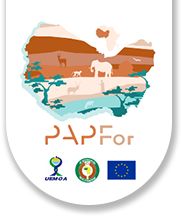Home / Guinean forests / Characteristics / The biodiversity / Species identity card / The Black-bellied pangolin
The Black-bellied pangolin
- Class: Mammal
- Order: Pholidotes
- Family: Manidae
- Genus: Uromanis
- Species : tetradactyla
- Weight: between 2.2 and 3.6 kg
- Size: 30 to 35 centimetres without tail; tail: 55-80 cm
- Diet: tree ants (Crematogaster and Cataulacus in particular)
- Habitat: very often near forested rivers or swamps
- Reproduction: births can take place all year round, as females can be fertile as early as two weeks after giving birth. A single infant is born in a tree hole.
- Adaptation: this species has a particularly long tail that enables it to keep its balance when climbing trees, but it mainly uses its tail to cling onto branches.
Because this species lives in areas that are difficult to access and infested with stinging ants, and because it is small and shy, this arboreal species is slightly less threatened than the other more terrestrial species: the species is considered Vulnerable, whereas the other two West African species are Critically Endangered.
Most species of pangolin are in danger of extinction due to local trade in its meat and international trade in its scales, which are sold mainly in China for traditional medicine. Several hundred thousand pangolins are killed every year in Africa. In 2021, for example, China confiscated a stock of 23 tonnes of pangolin scales from Nigeria.
Due to heavy hunting pressure, protected areas play an essential role in the survival of West African pangolins. PAPFor landscapes are all home to at least two species of pangolin and are therefore important for the survival of these species.


